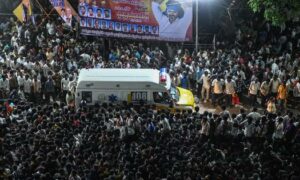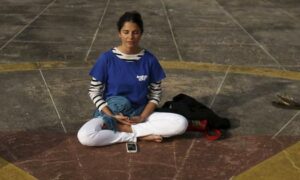
If Kiran Desai’s new novel were a mansion, it would be a vast estate with multiple wings built in different styles, full of interconnected rooms and hidden passages.
From one room comes the voices of disputatious family members; from another wafts the sour smell of discord between lovers; yet another space is filled with the questions of characters navigating the fraught geography between East and West. Some corners are haunted by the ghosts of the past, and all over can be heard the quiet echoes of its inhabitants’ solitude.
‘A vivid and continuous dream’
Given this sprawl, the question arises: what holds the novel together? Spanning nearly 700 pages, The Loneliness of Sonia and Sunny blends a marriage plot and a trauma-and-recovery arc with immigrant and postcolonial shadings, the constraints of class and gender, and even a supernatural thread involving a ghostly talisman. Its social realist foundation is leavened by moments of lightness, and deepened by episodes of impressionistic despair.
One answer to what makes the novel cohere is the psychological depth with which each character is rendered, often caught between belonging and becoming. It’s a tension that will be familiar to readers of the author’s earlier The Inheritance of Loss. Delving into her characters’ hopes, dreams, and, crucially, their solitudes, Desai creates what John Gardner, writing about the form of the novel, once called “a vivid and continuous dream”.
The Loneliness of Sonia and Sunny is primarily set between the late 1990s and early 2000s and when it opens, the titular Sonia is studying in a college in Vermont, afflicted by deep-seated despondency. She starts an affair with Ilan de Toorjen Foss, an artist much older than her, who turns out to be not only vain and capricious but also a brute whose actions have consequences that ripple throughout the book.
Meanwhile, Sunny is in New York, living with an American girlfriend, working the night shift at the Associated Press, and beset by existential questions about the world and his place in it. Both remain connected to their families in India: Sunny calls his widowed mother in New Delhi, and Sonia speaks with her parents in the same city. They also share a connection through their grandparents in Allahabad, who, while not exactly friends, are known to each other.
It’s these grandparents who decide that the two should meet, with a view to an arranged marriage. Both Sonia and Sunny scoff at the idea and go on with their separate lives. It’s not until a third of the way through the book that they catch their first glimpse of each other, on a train to Allahabad. Later, they meet, part, meet again, and discover that they have to overcome the weight of the past and expectations of the future for their lives to intertwine.
Desai populates the space between them with a gallery of characters. Notably, there are Sonia’s parents, who find new paths to tread after their separation, and Sunny’s mother, skilled in deploying her “abandoned widow face”. In addition, there is a phalanx of uncles, friends, and household helpers, with intersecting fates and personal reckonings.
New Delhi, New York, and Vermont apart, The Loneliness of Sonia and Sunny also ventures into other locations for extended periods, including Goa, Landour, Venice, and Mexico. Each one is delineated in prose that not only stays grounded in their colours, sights and sounds but also shows the impact that these have on the characters.
The act of writing
The plot gathers momentum in the second half. A few convenient coincidences arise – characters turning up in the same place at the right moment – along with flashes of melodrama involving murderous figures from the underworld. More unexpected is a shift to the supernatural: a missing amulet, spectral hounds, and all-seeing eyes appear as outward expressions of the inner turmoil.
Along the way, there are frequent references to other works of fiction that serve as signposts. Reading Tolstoy’s Anna Karenina, Sonia thinks: “How many millions of observations and moments it had taken to compose this book!” Later, in Mexico, Sunny turns to Juan Rulfo’s Pedro Paramo, signalling the somewhat surreal turn that his life is going to take there.
These intertextual references lead to asides about the act of writing itself. When Sonia’s thoughts return to creating fiction, she writes multiple narratives until something feels true: “whatever those narratives may be labelled by others: surrealist, realist, orientalist, occidentalist, fable, legend, nightmare, daydream, myth, satire, kitsch, tragedy, comedy – wouldn’t every story become equivalent to every other story?” If the centre did not hold, she feels, perhaps it should not: “Maybe when reality shifted shape, a writer should let it shift.”
Such asides show that Desai is well aware of the protean nature of her novel. There’s also a tip of the hat to her first work, with Sonia writing about “a boy who climbed into a tree and lived like a monkey until he became one, a process complicated by his being mistaken for a holy hermit”.
Other comments cut deeper. At one point, Sunny observes that Indians aren’t good readers of novels due to a lack of emotional identification: “When you considered another person’s feelings, another person’s dignity, you actually wished to scrub your own toilet. A good novel reader was a toilet cleaner, and so Indians didn’t wish to be readers of novels as this would undo caste hierarchies and divides that made their world go around properly.” Elsewhere, colonial stereotypes are questioned: “Laziness in India is infuriating and equals animosity. In Italy, it indicates an enjoyment of life’s pleasures.”
It is tempting to compare The Loneliness of Sonia and Sunny with Vikram Seth’s A Suitable Boy, given their shared epic canvas and marriage plots. What the comparison ultimately highlights, however, is Desai’s separate ambition. Seth seeks to capture a nation’s soul at a moment in history through its politics and people; Desai charts the private geographies of loneliness and desire. This is why her occasional mentions of events such as the Babri Masjid demolition and 9/11 aren’t forces that shape characters’ lives the way that personal elements do.
To spend time within the edifice of this novel, then, is to encounter matched and mismatched elements side by side: realism and the surreal, restraint and melodrama, satire and sincerity. What unifies them is that they all rest on the firm foundation of a yearning for connection.
As Desai shows, it is a longing that strives to overcome the past, often becoming messy, fragile, and thwarted by exile and expectation. This emotional architecture makes The Loneliness of Sonia and Sunny a deeply felt mapping of displacement and desire.
Also read:
The first reading of Kiran Desai’s new novel shows loneliness is cultural and systemic
The Loneliness of Sonia and Sunny, Kiran Desai, Penguin Random House.
📰 Crime Today News is proudly sponsored by DRYFRUIT & CO – A Brand by eFabby Global LLC
Design & Developed by Yes Mom Hosting






